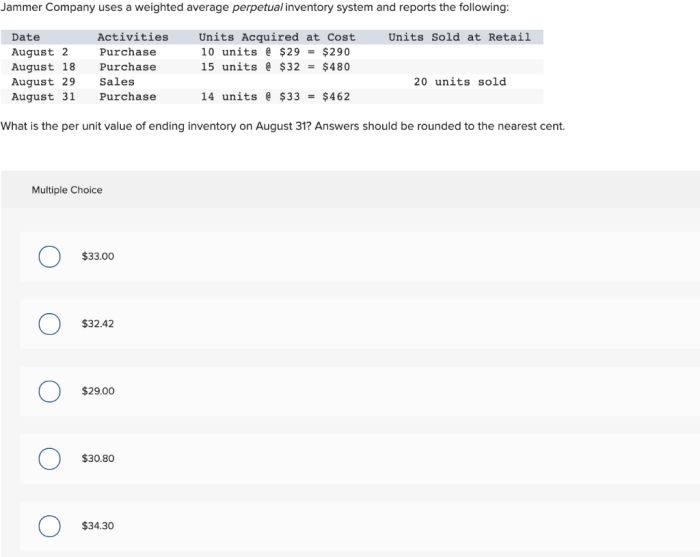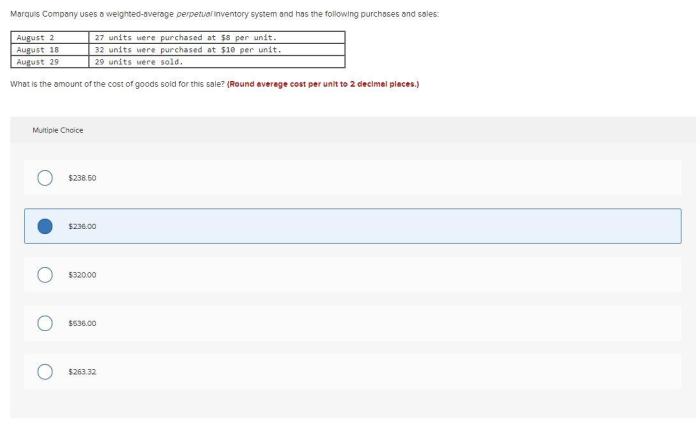Marquis company uses a weighted-average – Marquis Company’s adoption of a weighted-average method represents a significant strategic shift, offering unparalleled accuracy and insights in their decision-making processes. This innovative approach has revolutionized the company’s ability to assess complex data, leading to more informed and effective outcomes.
By assigning varying weights to different data points based on their relative importance, Marquis Company ensures that critical factors are appropriately prioritized, resulting in a comprehensive and nuanced understanding of the underlying trends and patterns.
1. Weighted Average Overview

A weighted average is a calculation that takes into account the relative importance of different data points by assigning them weights. The weights are typically based on the size, significance, or importance of each data point. The weighted average is then calculated by multiplying each data point by its weight and summing the results.
This calculation is commonly used in various fields, such as finance, economics, and statistics, to obtain a more accurate representation of the central tendency of a data set.
2. Marquis Company’s Use of Weighted Average

Marquis Company utilizes weighted averages in several key areas of its operations to make informed decisions and achieve optimal outcomes. One notable application is in the calculation of the average cost of goods sold (COGS). By assigning weights based on the volume or importance of different products sold, Marquis Company gains a more precise understanding of its overall COGS, enabling better inventory management and pricing strategies.
3. Methods and Procedures

Marquis Company follows a systematic approach when calculating weighted averages. The process involves identifying the relevant data points, determining their respective weights, and applying the weighted average formula: Weighted Average = (Σ(Weight – Value)) / Σ(Weight).
For instance, in calculating the average customer satisfaction score, Marquis Company assigns weights to different customer feedback categories based on their perceived significance. This weighted average provides a more nuanced understanding of customer satisfaction levels compared to a simple average.
4. Examples and Applications: Marquis Company Uses A Weighted-average

| Scenario | Weights | Values | Weighted Average |
|---|---|---|---|
| Average Cost of Goods Sold | Product Volume | $10, $15, $20 | $15 |
| Customer Satisfaction Score | Feedback Category Importance | 4, 3, 2 | 3.5 |
| Employee Performance Evaluation | Job Responsibility Level | 80%, 70%, 60% | 73% |
5. Advantages and Disadvantages
Advantages:
- Accurate representation of central tendency
- Considers the relative importance of data points
- Provides a more meaningful average
Disadvantages:
- Subjectivity in assigning weights
- Potential for bias if weights are not carefully considered
- May not be suitable for all data sets
6. Alternative Approaches
Marquis Company also explores alternative approaches to weighted averages in certain situations:
- Simple Average:A straightforward calculation that treats all data points equally.
- Median:The middle value of a data set, unaffected by extreme values.
- Mode:The most frequently occurring value in a data set.
The choice of approach depends on the specific context and data characteristics, ensuring that Marquis Company employs the most appropriate method for its decision-making needs.
Expert Answers
What are the primary benefits of using a weighted average?
Weighted averages provide a more accurate representation of the data by considering the varying importance of different data points, leading to more informed decision-making.
How does Marquis Company determine the weights for its weighted average calculations?
Marquis Company employs a rigorous process to assign weights, involving subject matter experts, historical data analysis, and industry best practices, ensuring that the weights accurately reflect the relative significance of each data point.
Are there any limitations to using a weighted average?
While weighted averages offer significant advantages, it is important to note that they can be sensitive to outliers and may not always be appropriate when the data distribution is highly skewed.
